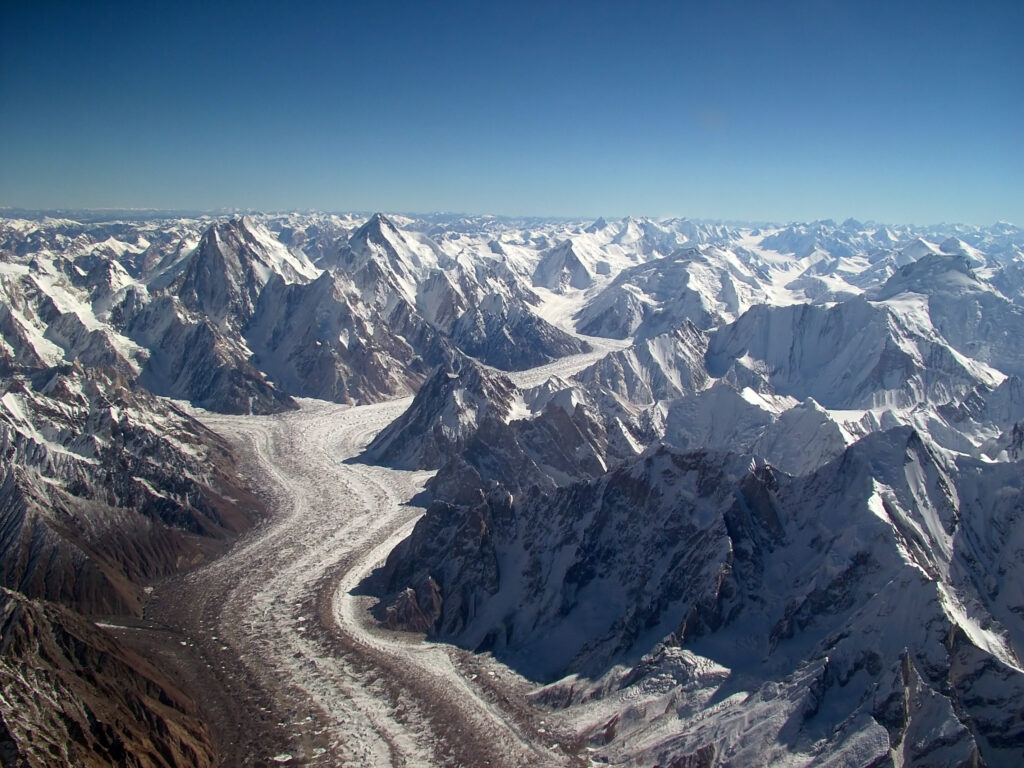In 2024, an Italian scientific study focusing on high-mountain environments revealed that Pakistan is home to 13,032 glaciers, the largest concentration outside the polar regions. These glaciers span an area of 13,546.93 square kilometres (5,230 square miles) across the Gilgit, Indus, Jhelum, Kabul, and Tarim river basins, forming a critical source of freshwater for the nation’s 220 million people.
Pakistan’s unique geography places it at the convergence of three of the world’s most significant mountain ranges—the Hindu Kush, the Himalayas, and the Karakoram—meeting in Pakistan-administered Kashmir. This topography not only gives Pakistan strategic importance but also makes it one of the most climate-sensitive regions in the world.
Glaciers in Crisis:
The glaciers in the Hindu Kush Himalaya (HKH) region are melting at an alarming rate. According to a recent study by the International Centre for Integrated Mountain Development (ICIMOD), glaciers melted 65 percent faster during 2011–2020 compared to the previous decade.
The rate of melting varies by region:
• Himalayas: 10–30 metres per year
• Hindu Kush: 5–10 metres per year
• Karakoram: 2–3 metres per year
Longer, hotter summers are causing glaciers to melt faster than snowfall can replenish them. This accelerated loss is putting immense pressure on Pakistan’s Indus River system, which sustains nearly 90 percent of the country’s agriculture.
Forests: Vanishing Natural Barriers:
Pakistan’s land features a striking contrast—from glaciated zones to fertile plains and arid deserts. Despite this diversity, only 5.23 percent of the country is forested, offering limited natural protection against erosion, landslides, and floods.
According to Global Forest Watch, Pakistan lost 95.3 square kilometres of forest cover between 2001 and 2024—almost half the size of Islamabad. The causes include:
• Logging (78%)
• Wildfires (12%)
• Permanent agriculture (5%)
• Natural disasters (2%)
• Urban development (2%)
Over this period, nearly 8 percent of the country’s tree cover disappeared, driven by both permanent deforestation and temporary environmental disturbances.
The Monsoon Menace:
Pakistan depends heavily on the South Asian monsoon, which provides nearly three-quarters of the region’s annual rainfall. However, as the climate shifts, rainfall patterns have become increasingly erratic. Instead of steady, predictable rains, cloudbursts and intense downpours have become more frequent, triggering flash floods and landslides across vulnerable mountain and river valley areas.
The floods of recent years have been especially destructive, compounded by the country’s limited reservoir capacity. As existing dams and storage facilities fill to the brim, the risk of uncontrolled flooding continues to grow.
A Country at Risk:
Pakistan stands at the frontline of the global climate crisis. It hosts the largest volume of glacial ice outside the polar regions and is a vital water source for South Asia. Yet, its forests are shrinking, and its glaciers are vanishing, putting both agriculture and infrastructure at severe risk.
As monsoons grow more unpredictable and glaciers retreat faster, Pakistan must prioritize climate resilience—from protecting forests and expanding reforestation efforts to investing in better water management and climate-adaptive infrastructure.
Without urgent action, the combined impact of glacial melt and deforestation could lead to worsening water scarcity, agricultural decline, and increased vulnerability to natural disasters for millions of Pakistanis.
















